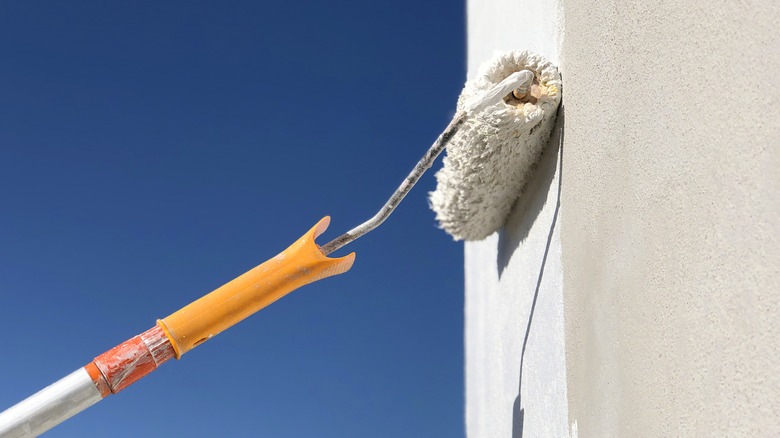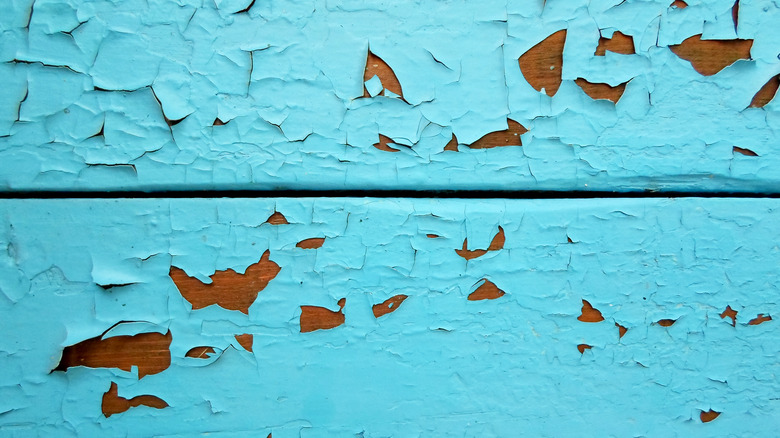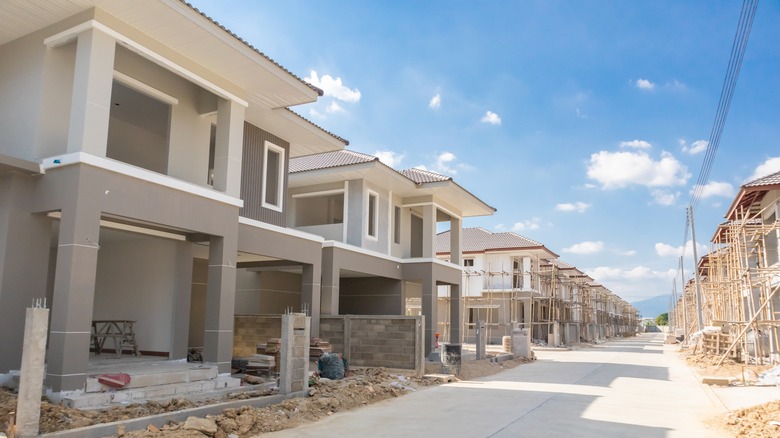Signs It's Time To Repaint Your Home's Exterior
Adding a fresh coat of paint can completely change the outside appearance of your home and keep it looking modern and fresh. While there are plenty of aesthetic reasons why you may want to repaint your home, what many people don't realize is that paint is also an important part of protecting your house from wind, rain, sun, and snow. In fact, exterior house paint is specifically created to be weather and UV-resistant which helps protect your home and keep it safer for longer. This is why it is important to be on the lookout for any signs that your home needs a fresh coat of paint.
On average, most people will need to repaint the exterior of their home around once every five to ten years. However, this number also depends on what materials your home and siding are made from. According to John McCarter Construction, houses with wood siding need to be repainted every three to seven years while stucco and aluminum-sided homes should be repainted around once every five years. On the other hand, coats of paint on brick and fiber cement siding may last more than a decade. It all depends on your home, climate, and the quality of the paint used. Here are some signs to look out for that mean your house needs to be repainted soon.
Paint that is peeling or bubbling
Paint that is peeling off, cracking, or bubbling is an obvious sign that your home could use a new coat of paint. This is especially important because peeling or missing paint will leave the siding of your home vulnerable to weather damage. Homes that are left with exposed siding for too long may even develop mildew, mold, or rot that will eventually require portions of siding to be replaced, leading to a hefty bill.
For a quick fix, you can always just repaint the area of your home where the paint is starting to peel or crack. However, cracking paint can have a few causes from the paint not being applied properly to it simply being too old and no longer able to face the elements. Because of this, once one area of your exterior paint starts peeling, it is quite likely that the rest will follow in a year or so. This is why many painting companies recommend repainting the entire house once one area starts cracking.
While it may be more expensive, paying for higher-quality weather-resistant paint is a good way to make the exterior paint job last longer.
The color has faded or is weirdly chalky
While most outdoor paint is UV-resistant, over time, the strength of the sun's rays will cause your house's paint to start fading. This is especially true if you live in a hot and sunny climate and your house doesn't have much shade protection. However, while fading paint does make your house look a little worn for wear, it is also more than just an appearance issue. In fact, fading is often one of the first warning signs that your paint is not standing up to the weather as well as it used to.
Besides the color fading, another sign that your paint is on its last legs is if it starts to develop a chalky coating. This white powdery coating may look weird, but is normal with older paint and happens as the paint wears down and reacts to the elements. For a quick fix, you can try pressure washing the chalky powder away. However, if your house is still covered in white powder or if it returns after pressure washing, this is probably a sign you need to repaint as your old coat of paint is not weathering well. Unfortunately, paint doesn't stick well to chalky surfaces so all the powder will need to be completely removed before a new coat can be added.
Your home is showing signs of damage
While paint helps protect the siding and outer walls of your home from weather damage, it can also hide certain types of damage that are occurring inside your walls. This is why it is especially important to examine the outside of your house for any signs of water damage. This can be anything from water stains in the paint to new gaps between wooden boards or cracks in the caulking of your home. If you see signs of water damage or dry rot in your home it may be necessary to replace and fix the problem before going over the area again with a new coat of paint for posterity and protection.
Furthermore, if your house experiences any damage from storms or other acts of God, it may be necessary to repair and then repaint these damaged sections of your home. If you don't want to repaint your entire house, it is possible to repaint only the affected areas. However, it is important to know that finding the exact shade of paint that will match the color of your home (which may have faded or changed slightly) will be difficult. This is why it is usually recommended to repaint entire sides or sections of your home to make the color difference less noticeable between the new and old coats.
You plan to put your home on the market
Repainting your home before putting it on the market is a great way to make it look more striking to visitors and to increase its value. In fact, according to Elite Trade Painting, while a new paint job may cost around $1,500 to $3,000, it can increase the value of your home anywhere from $5,000 to $10,000. A prospective buyer may also be a little more willing to buy a home that they won't have to repaint as opposed to purchasing a home that badly needs a new paint job. Furthermore, a recently painted home shows buyers that you've put in the effort to maintain the home over the years and haven't let problems fester.
Updating your home's color scheme can also make it look newer. This will help it fit in better with the other homes in the neighborhood and increase its curb value — or how striking and beautiful a home looks from the street. Before repainting, try to research modern color schemes and avoid colors that tend to look dated like tan, brown, and green.
The home is newly built
If you are the first person to live in your home because it is brand new, then you may want to consider repainting the exterior of your house even if the paint isn't currently showing signs of wear. The reason for this is that more often than not, new homes are painted quickly by contractors with one coat of low-quality paint and no primer. This is done because builders often get good deals on bulk products and opt for lower-quality paint that comes with discounts. This means that the original coat of paint on your new home may not be able to protect your siding like a professional paint job would. Professional painting often involves multiple coats of high-quality weather-resistant paint that will last longer and offer more protection.
Because of this, when purchasing a newly built home, it's always a good idea to ask for details such as the type of paint that was used and the number of layers added. This will help give you more information on the durability of the paint and help you predict and prepare for repainting.





